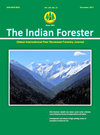Traditional Knowledge of Broom Making from Date Palm (Phoenix sylvestris Roxb.) for Sustainable Livelihood in Madhya Pradesh, India
DOI:
https://doi.org/10.36808/if/2017/v143i12/120395Abstract
No Abstract.References
Gundimeda H., Sanyal S., Sinha R. and Sukhdev P. (2005). The value of timber, carbon, fuelwood, and non-timber forest products in India's forests. Monograph 1 of the Green Accounting for Indian States Project (GAISP), TERI, India.
Hegde R., Suryaprakash S., Achoth L. and Bawa K.S. (1996). Extraction of NTFPs in the forests of B.R. hills contribution to rural income. Economic Botany, 50: 243
Maithani G.P. (1994). Management perspectives of Minor Forest Produce. MFP News, Dehradun.
MoEF (2006). Ministry of Environment and Forests. Report of the National Forest Commission. New Delhi: Ministry of Environment and Forests, Government of India. 421 pp.
MoEF (2009). Ministry of Environment and Forests. Asia-Pacifc Forestry Sector Outlook Study II: India Country Report. Working Paper No. APFSOS II/WP/2009/06. Bangkok: FAO pp 7
NAEBRC Mumbai (2010). RC-195 Study on Documentation on best agroforestry model developed in JFM areas of Gujarat. NAEB Report, pp.11.
Newton C., Muriel Gros-Balthazard, Ivorra S., Paradis L., Pintaud J.C. and Terra J.F. (2013). Phoenix dactylifera and P. sylvestris in Northwestern India: A Glimpse of their Complex Relationships. Palm, 57(1): 37-50.
The Hindu (2014). Brooms find a ready market in North. The Hindu Special Correspondence Kurnool, April 9, 2014.
World Bank (2006). India: unlocking opportunities for forest dependent people in India. Report - IN, World Bank: South Asia Region, 85:34481.
Downloads
Downloads
Published
How to Cite
Issue
Section
License
Unless otherwise stated, copyright or similar rights in all materials presented on the site, including graphical images, are owned by Indian Forester.





